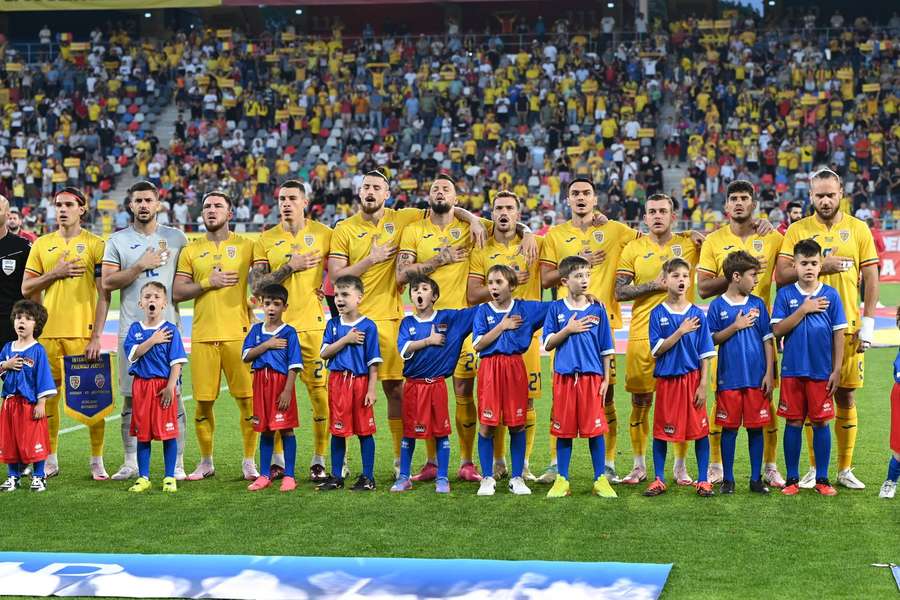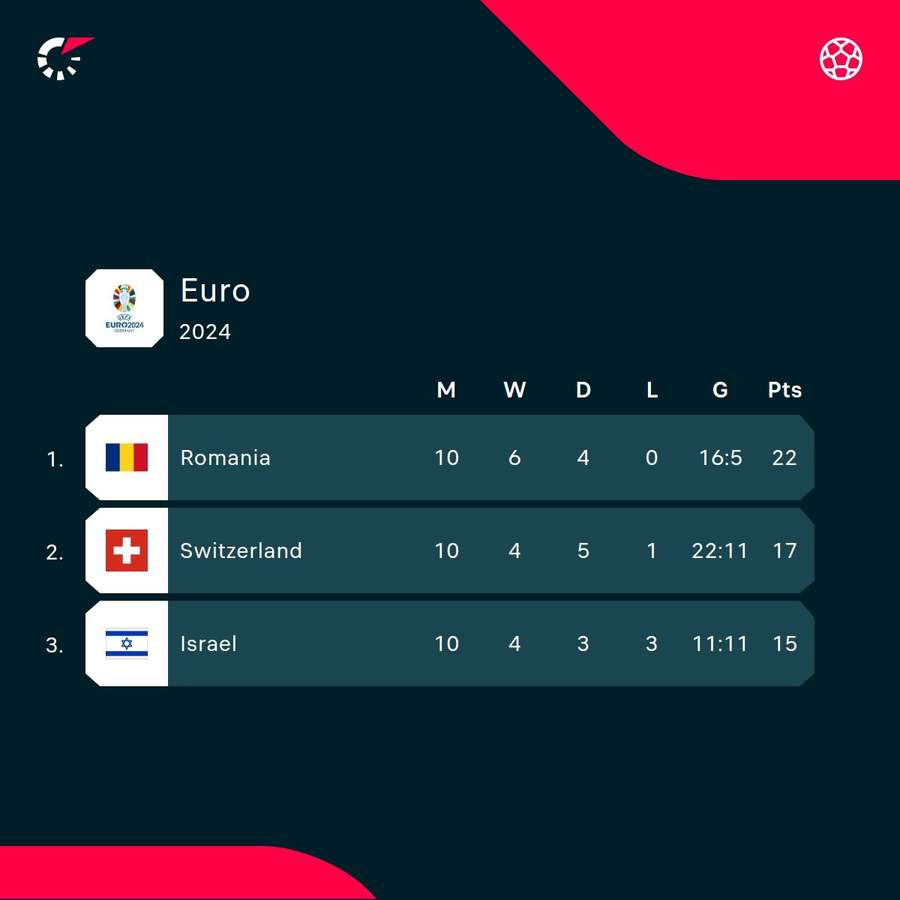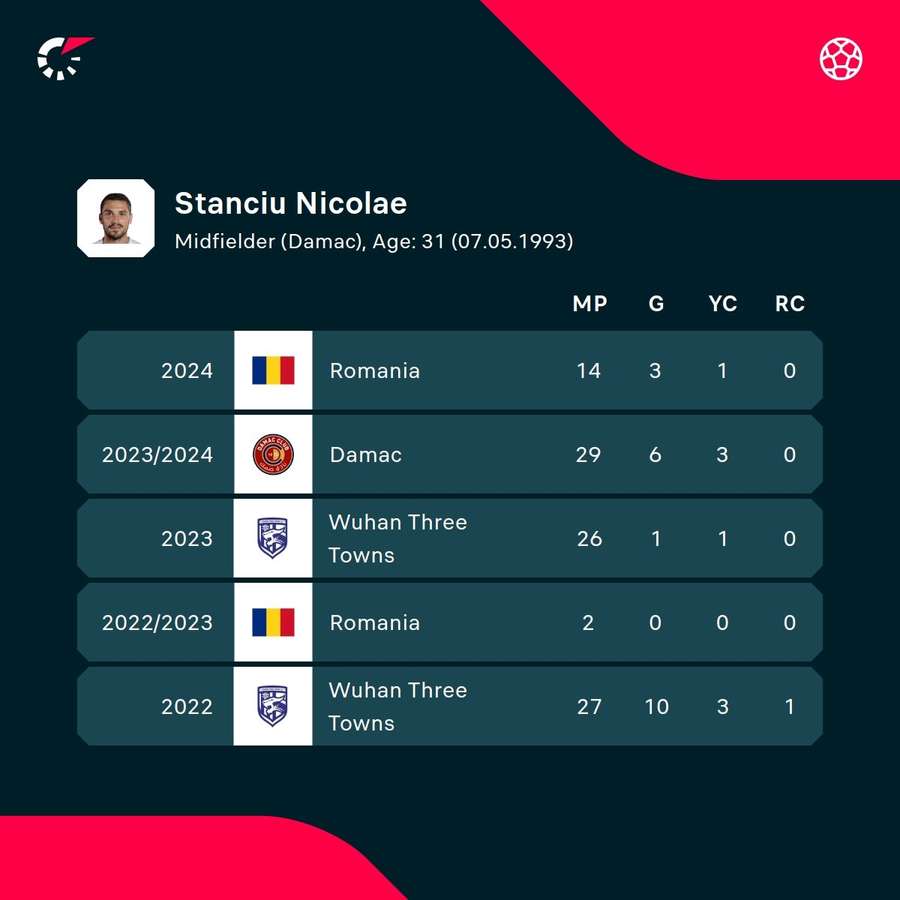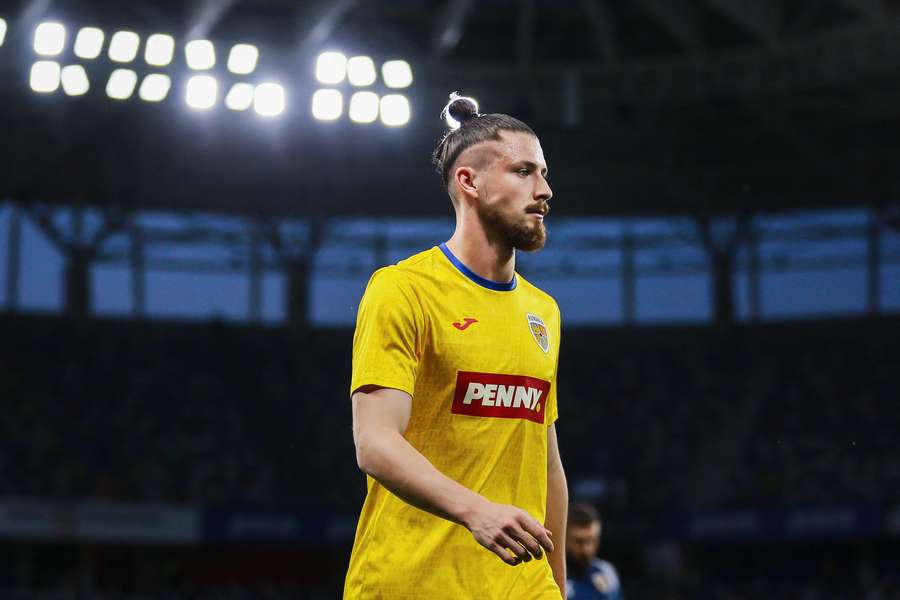EURO 2024 Preview: Romania look to defenders to navigate unlikely path from group stage

Let's start light-heartedly. Romania, especially the Transylvania region, has many people in the world associated with vampires. With Edward coaching this tournament and Anghel coaching the previous one (remember Buffy the Vampire Slayer?), many people would expect that perhaps Count Dracula must have led Tricoloria in the previous one. Unfortunately, Victor Piyurca, the coach at the time, is said to be able to see in the mirror and even eating garlic doesn't give him problems.
Jokes aside, the Romanians flew through the qualification surprisingly smoothly and did not lose once in 10 matches. Romania doesn't lose much at all infact. In March, it lost to a spirited Colombia 3-2, but before that they had a run of 12 matches without defeat.
While statistically interesting, the quality of the opponents, with a few exceptions, did not match the strength of the Romanians' group at the Euros. Qualifying Group I, with a slightly retreating Switzerland, troubled Israel and Belarus, and outsiders Kosovo and Andorra, was one of the weakest ever, along with Groups G and H.

This, by the way, is again an interesting parallel with 2016, where the Romanians were similarly, perhaps even more, unlucky. Back then, they were knocked out of the first play-off by Greece, who "managed" to finish last in the group behind the Faroe Islands.
The competition at the finals from Belgium, Ukraine and Slovakia will be more of a challenge for the Romanians. But the prospect of eventual promotion is not utopian. The defence is working relatively well and the squad has several wingers with a very good playmaker, Stancis.
The problem, however, is scoring goals. In the friendlies before the tournament with Bulgaria and Liechtenstein the attacking performance was desperate and both games ended in goalless draws. However, the Romanians will not be expected to make plays into a closed defence in either game. If they have the opportunity to crawl into their shell, they will do so and it will be very difficult to penetrate their concrete. So the ceiling of Romanian performance is not staggeringly high, but at the same time it doesn't usually fall below a bearable level either, and with improved finishing they can beat anyone.
Road to the Finals
While the Romanians are often drawn into rather difficult groups in the final tournaments, luck favoured them in the qualifiers. Indeed, two of their opponents, Belarus and Israel, have played 10 away games due to political situations. Switzerland was the biggest favourite in the group and, although they were brimming with confidence, they had to bow down to the Romanians in the end.
The interesting thing about the Romanian results is the higher number of goals conceded. The Romanians do struggle to score a goal, but when the joy came, four times within 10 minutes a second goal followed. This happened against Belarus, Kosovo, Switzerland and Andorra. They are often the first to score, as they did six times.
After the opening wins against Andorra and Belarus, a goalless draw came on the field of Kosovo. But given the number of Kosovo draws, it was practically not a loss as much as an expected affair. Moreover, Kosovo dominated the match and the Romanians could only muster a few dangerous shots from distance. The hero of the match was goalkeeper Horatiu Moldovan, not for the last time.
Moldovan also put in an important performance in the next match against the Swiss. There, despite the two goals he conceded, he held his team several times, giving Valentin Mihail the opportunity to equalise with two goals at the end after breakaways on the left wing. It must be said that the Swiss way of defending at 2-0 seemed a bit naive...
However, at the very end of the set time, the Swiss could still have equalised when Bislimi was left completely uncovered at the back post and hit the crossbar. The subsequent draw with Israel did not help or hurt the Romanians.
Perhaps the turning point was the home win over Kosovo, where the visitors were once again the better team until Muriqi's stupid sending off. But the Romanians, again with a lot of help from some dedicated, if positionally not quite accurate, defending, managed to pull the game back to their side. However, the team was rightly criticised by many former players, such as Gheorghe Popescu, for being too passive during the qualification. I would add that the Romanians could thank the poor quality of their opponents and the fact that Israel played their home games in nearby Hungary more than their own ability.
Despite a mere draw in Belarus, the Romanians were in a good position with two rounds to go, but not as comfortable as they had hoped. Like the Swiss, they had 16 points and the Israelis had 12, but the Romanians had 'away' games against Israel and home games against the Swiss, while Israel's last game was against Andorra. Israel went ahead in the second minute of the match after Eran Zahavi's header, but the key was a quick equaliser from a header by Puscas.
Here, for once, the Romanians' efforts to shoot from long range finally paid off, as the Romanian striker only finished the deflected ball into a half-empty net. Despite another less than convincing performance, the Romanians eventually turned the game around thanks to Hagi, and the last match against Switzerland was a mere formality for both teams.
Coach - Edward Iordanescu
Ianis Hagi is not the only son of a legend in the Romanian squad. Anghel Iordanescu, Edward's father, was present as coach at some of the most important moments in Romanian football history.
His son has therefore at least partially matched his father's achievements, but his coaching work is not among the best in the competition of other coaches at the tournament. As he progressed, however, he may have finally shaken off the label of the son of a famous coach.
Meanwhile, the still only 45-year-old coach has earned a decent reputation on the club scene while managing Gaz Metan Mediaş. After a stint at Cluj, with whom he won the title in his first season, he briefly tried his hand at managing the country's biggest club, FCSB.
However, it happened in Kocourkov, Romania, that two months after the historic 6-0 drubbing of their biggest rival Dinamo Bucharest, the quirky owner Gigi Becali fell out with the coach and sacked him. A month earlier, during the Covid-19 pandemic, Becali had harshly criticised all players and staff who had been inoculated against the virus and threatened them with sacking.
At the Euros, Iordanescu will rely heavily on a team concept complemented by the skills of his captain Nicolae Stancio, but the reunion of the names Iordănescu - Hagi is particularly interesting. The Alaves offensive midfielder has been struggling after a long injury and his performances remain far behind expectations, but the coach has always spoken highly of him. It is perhaps because of his return from injury that young Hagi is more than a key footballer for him, he is an example of the right combative attitude.
As for the coach's ambitions ahead of the Euros, he is keeping a healthy distance. In an interview with World Soccer magazine, he mentioned the steadily declining level of the Romanian league and the lack of Romanian players in the top five leagues. While some Romanians do play in Italy, they are almost exclusively Serie B players. Thus, Edward Iordanescu's main goal is more like to finally fight again after a long time, at least to win a match that Romanian fans haven't enjoyed for 24 years.
The team's driving force - Nicolae Stanciu
Well known to Czech fans, the Sparta and Slavia playmaker moved to a league in Saudi Arabia last year for the second time in his career, where he is earning his retirement. So perhaps, given his previous engagement in China, he is now earning a pension for his children. But he's still the same old Stanciu who entertained domestic fans with a number of imaginative passes. Perhaps it's just that his speed is fading faster than might be normal due to his time in exotic destinations, but he's never been much of a sprinter, the Romanian captain.
Playing the number 10 position in the current Romanian selection is no mean feat, as the team relies on you virtually implicitly in the midfield. Against Ukraine and Belgium, however, Stanciu will probably have a slightly easier position.

After winning the ball, he will act as a conductor of quick counter-attacks and his lower speed will not be a hindrance, as his position in finishing these counter-attacks is somewhere around the edge of the whitewash. While Stanciu's kicking technique is of a decent standard, he has a tendency to shoot the ball too high at times, especially when a defending player manages to put pressure on him.
In fact, this might also be the last chance for Stancio to convince Romanian fans that he hasn't completely wasted his talent. When he represented Romania at the Euro in France eight years ago, he featured in our previews as a player "on the cusp of glory". Around the then 23 year old youngster circled for example AC Milan or Zenit St Petersburg.
He chose Anderlecht, which didn't turn out to be the right choice (or he simply missed something). Now, at 31, the success or failure of the whole team rests on him. It's not easy to cope with that kind of pressure, so let's hope "Nicusor" can handle it.
On the threshold of glory - Radu Dragusin
Most of the Romanian players who made the final list are between the ages of 25 and 31. Radu Dragusin, a 22-year-old native of Bucharest, is the youngest player in the entire squad, yet he plays for clearly the best team - Tottenham Hotspur. The best competition could be goalkeeper Moldovan, but he has not yet played for Atletico Madrid this year.
Dragusin only transferred to Tottenham this January from Genoa and has not yet earned a stable place in the Spurs lineup, so the tall youngster's minutes are also not ideal, but he is a key stopper for Romania. We already know that Romanian coach Iordanescu places particular emphasis on the heart of the team, so the exemplary professional Dragusin, who in addition to post-training additions in the gym also prides himself on working with a video analyst with whom he works to improve positional play, fits right in with his concept.
The young, 191cm tall Romanian is a strong, tough and positionally proficient defender for his age. However, at times he can't forgive himself for some unnecessarily risky defensive interventions. However, he has also worked significantly on his build-up play at Genoa and ranks third among the defenders in terms of successful passes and successful crosses in his own half.

This statistic normally doesn't necessarily mean that a defender is a quality playmaker, but Dragusin was also 11th in the entire league in the number of times he was involved in varied passing sequences. Simply put, he played an important role in the construction of his team's play.
Apart from that, he also greatly supports the offense by trying to bring the ball forward progressively. In short, Dragusin has the potential to be a world-class all-round defender.
But at the same time, one could say, "There have been others like him..." Romanian players simply often get stuck at some point in their development, whether due to injury or for other reasons.
This is also true for some of Dragusin's current national teammates, whether it's Dennis Man, Florinel Coman or to a large extent the team's workhorse Nico Stanciu. They all had similarly high aspirations at Dragusin's age. But the Tottenham centre-back seems to have his head set on the right track, which is usually the most important criteria for success.
His representative role is different to what he was used to playing at club level. Whereas at Genoa the right-footed stopper usually started on the left (and at Tottenham he has hardly started at all so far), in the national team he starts from the right. However, due to his completely different style of play, he is unlikely to make much use of his qualities in the construction of the game at the Euros.
The team will rely more on his speed, strength in the air and also his undeniable qualities in stopping attacks on the ground. On his team's ambitions, Dragusin himself commented: "The goal is to advance from the group. Only if we get out of it can we set ourselves further goals." Well, there's no arguing against that.
Likely lineup and tactical profile of the team
It may be harsh to start a chapter on team tactics by saying that the Romanians are not enjoying the game, but it is unfortunately a characteristic feature of Iordanescu's team. The defensive work has been relatively reliable, the Romanians often defend with their hearts rather than having refined defensive patterns.
As a rule, Romania enters the match with a variation of the 4-3-3 formation, either officially 4-2-3-1 or 4-1-4-1. Practically, though, it's always two central midfielders, Stanciu at attacking midfielder and an offensive trident with two wingers and a striker.
In the friendly with Bulgaria, Iordanescu tried out the speedster Dragus on the tip, who he otherwise used on the wing - the move didn't work, but the problem wasn't so much Dragus as the inability of the midfield and wings to deal with the careful Bulgarian zone. If you stop Stanciu, the Romanians are virtually toothless in the midfield, while in theory, for example, Radu Dragusin can send quality progressive passes into the midfield.
In practice, passing from their own half follows a 2-1-4-3 or 3-4-3 formula, with one of the central midfielders withdrawing between the central defenders. But the combination would need to speed up substantially. Moreover, the wingers and wing-backs are seemingly high up, but they don't rush into attacking runs.
However, the quality of the transition phase will be more important for the Romanians than the distribution from their own goal. Playing without the ball, the Romanians then retreat into a pre-drawn formula, e.g. 4-1-4-1/4-2-3-1 with a condensed midfield. In breakaway situations, wing work will be important.
A popular move is to move the ball to the right winger, usually Dennis Man, who then looks for a pass underneath him on the edge of the whitewash to Stanciu, or to the near post to a rebounding playmaker or left winger. It's quite legible, but very difficult to defend if played well. If the quick attack is slowed down, the aforementioned mid-range shot will probably follow. Perhaps the Romanians will save their efforts to build the game at least until perhaps the crucial game against Slovakia.
The hero of several qualifying matches, Horatiu Moldovan, has made a big transfer to Atletico Madrid after a successful autumn in the Rapid Bucharest jersey. However, playing as a number two to Jan Oblak meant that Moldovan has not yet made it into a competitive match.
He did, however, play the whole qualification, with the exception of the first two matches, and he did it very well. His greatest strength is his excellent reflexes when finishing from close range, but he can have exceptional problems with taming shots from distance.
With all due respect to Romania's left-back, this position is probably the team's biggest weakness. Nicusor Bancu was the number one choice for the coach in the successful conclusion of the qualifiers. He is an offensive-minded player from the domestic league, where he had a respectable 2+9 record in Craiova's jersey this season, but as already mentioned, the Romanian league is more of a European average.
Another pure left back is missing from the squad, but Deian Sorescu, who is also capable of playing wing, will eventually be an alternative for Banca. However, he is a right-handed player whose primary position is not the left edge of defence. Vasile Mogos, probably the biggest surprise of the entire nomination, is also right-handed. This post is thus a critical spot not only for performance reasons, but also for personnel reasons.
On the right edge of defence, Andrei Ratiu will probably start, whose blue "comedy head" will shine like a beacon on the pitch. Ratiu's workload in Spain is less than ideal, so he will not be a strong point in the Romanian lineup either. Hypothetically, apart from the aforementioned Mogoş, stopper Andrei Burca can also step in on the right edge of defence, but he is primarily counted on at stopper.
The experienced player of Saudi Arabia's Al-Okhdood can be very productive - he scored six goals in the league. His big moment was the goal against Belarus, when he ran into the penalty area from his position as a stopper and, as an experienced striker, he directed the ball beautifully to the bar under pressure with his feet. The other stopper will be the talented young Radu Dragusin.
Both defenders are right-footed, so the younger and better-placed Dragusin will get the better position on the right. The Romanians don't have a single left-footed stopper in their squad. The best alternatives are young Bogdan Racovitan or Adrian Rus. On the other hand, Napoli's Ionut Nedelcearu experienced a terrible end to the match against Bulgaria, which must have given the coach an early warning.
The midfield line-up has not changed during the whole qualification. Had it not been for the injury to Vladimir Screcia, he would probably have occupied the shield midfielder's post. Thus, the most likely deployment is Marius Marin, who, however, did not play his best game against Bulgaria. The remaining two spots are much easier to guess. The role of the classic "eight" will be filled by Razvan Marin, while the offensive role is reserved for Nicolae Stanciu. The Romanian captain is indispensable for Iordănescu, and in case of the need to open the game, he will be complemented by another creative player, Ianis Hagi, at the expense of M. Marin.
However, his form is far from ideal. In the event that both Hagi and Stanciu play, Razvan Marin will take the defensive role. The only other defensive midfielder in the squad is the inexperienced Adrian Sut. On the other hand, the coach has a plethora of offensive midfield players at his disposal, neither of the pair Darius Olaru, Alexandru Cicaldau are too different.
In fact, all the players start in a similar position on the wings. Ironically, I'll start with the first choice to come off the bench at left wing. This is Valentin Mihaila, with three goals one of the three top scorers of Romania in the qualification. In the starting line-up on the left wing, the former great talent Florinel Coman will probably start, who unfortunately has been slowed down by frequent injuries. Coman is a slightly more creative option than the more direct Mihaila, but his effectiveness is lacking.
Either way, they are both, as is typical nowadays, inverted wingers, opening up space in the centre for the outside backs - and Nicusor Bancu is certainly looking forward to that space. The right side will probably be occupied by Dennis Man, bringing solid form from the second Italian league. However, there is also the suggestion of deploying Ianis Hagi, who could help Stanciu with playmaking from the right wing. However, this model has so far worked more on paper than in actual games.
While the play of the wingers can potentially be the difference, the spike strikers don't come in good form - with one exception. That is Denis Draguş, who has so far been used mainly on the wing by Iordanescu. However, with the rather below-average form of George Puscas and Denis Alibec, his deployment in his usual place is on offer.
The last striker in the nomination, but who also did not convince at all in the preparation, is Daniel Birligea from Cluj. But who knows, maybe the Romanians will finally manage to fine-tune their form just before the Euros. The key is to get at least one draw against Belgium or Ukraine, so that there is still something to play for in the last game against Slovakia.
Match schedule - Group E
June 17th (15:00 CET) Romania vs Ukraine - Munich



